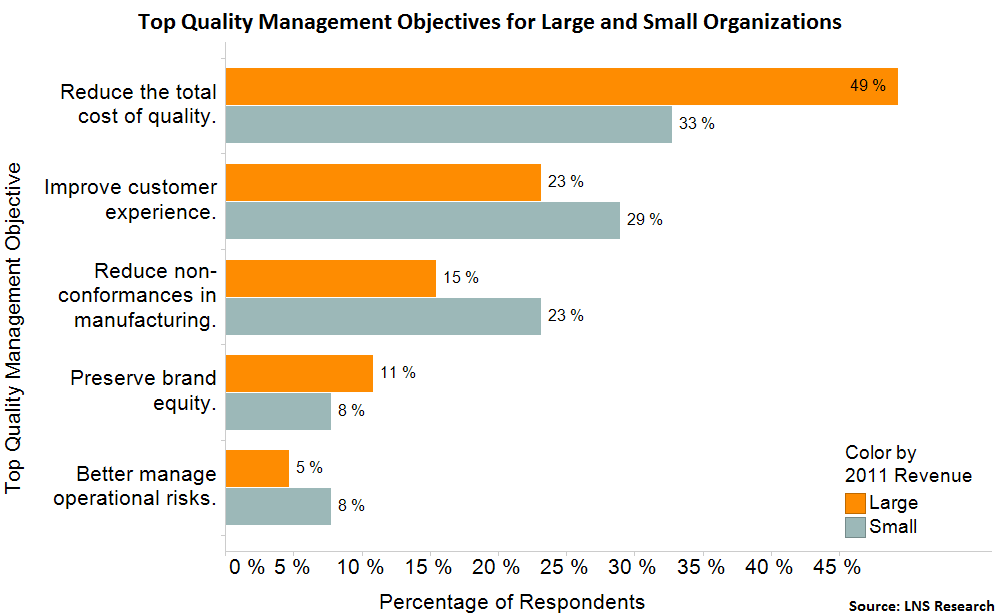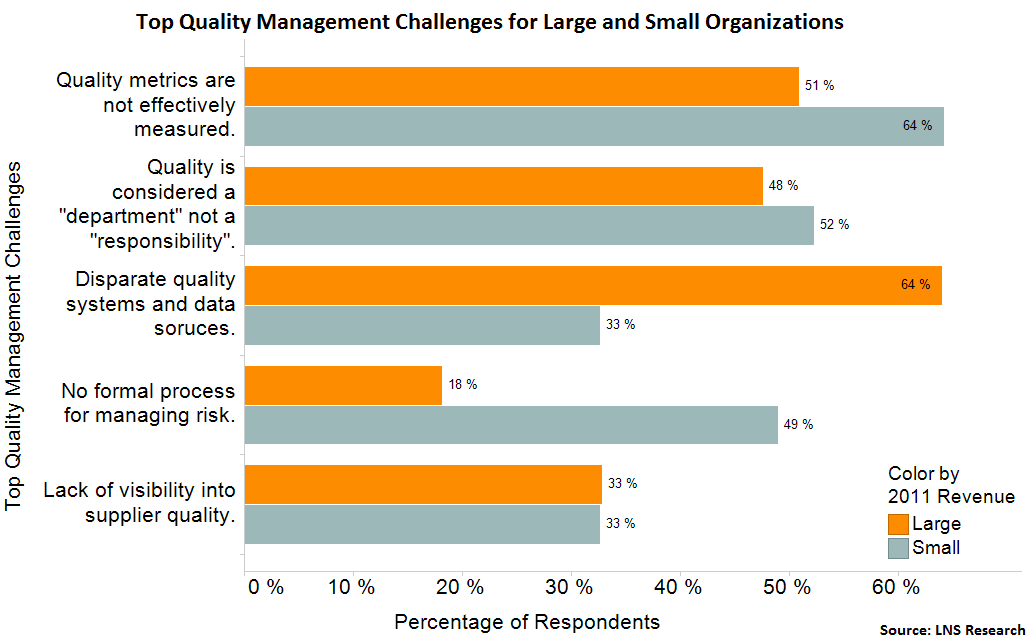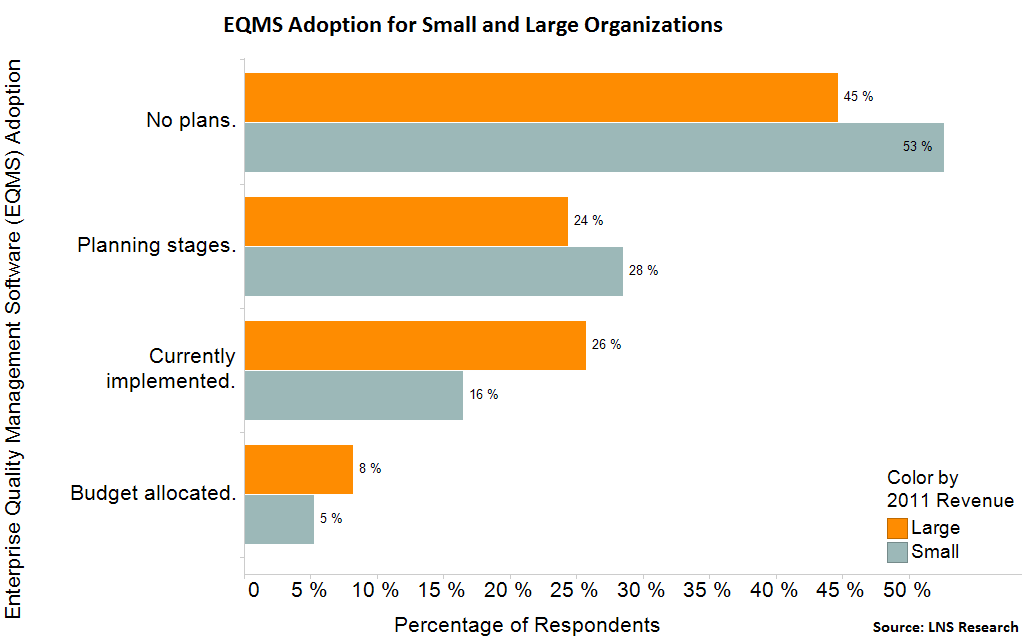When discussing quality management strategies, it's important to note the differences between small and large organizations. Often, the size of a company will greatly impact its focus points, challenges, and approaches in regard to ensuring the quality of products and processes. Interestingly, there can even be significant differences and similarities between company sizes within the same industry.
After providing revenue and company size information, the 2012-2013 LNS Research Quality Management Survey asked executives numerous questions that span across people, processes, technology, and quality metrics performance. In this post, we will use that data to conduct a side-by-side analysis of small (<$50MM in 2011 Revenue) and large (>$1BB in 2011 Revenue) organizations with regard to objectives, pain points, and IT strategies.
Top Quality Management Objectives
In one of our first questions, we asked executives what their top quality management objective was for 2012. They were limited to one answer. As shown in the chart below, 49% of executives from large organizations chose reducing the cost of quality, with 29% selecting improving customer experience. In contrast, the top two results for small organizations were relatively more even, with 33% of executives choosing reducing the cost of quality and 29% choosing improve customer experience.

Top Quality Management Challenges
When we inspect the data from the top quality management challenges in 2012, we see consistency in the differences between company sizes. For this question, executives were able to choose more than one challenge impacting their organization. At a quick look, two points stand out here. 64% of small companies find difficulty with effectively measuring quality metrics and 64% of large companies noted a challenge as having too many disparate quality systems and data sources.
In terms of quality metrics, it's probable that the difference in the responses between large and small organizations, 51% and 64%, respectively, stems from a combination of the maturity of quality culture, processes, and IT architecture. Larger organizations have likely invested higher amounts of capital in building out these competencies, which are instrumental to delivering consumable quality metrics data to all levels of the organization.
The challenge of having too many disparate systems and data sources resonates much more with larger organizations. These companies have likely gone through considerable periods of growth that may have involved M&A activities. Additionally, it's typical for larger organizations to have implemented quality management functionalities and processes in a piece-meal fashion rather than with a holistic, long-term vision, resulting in a diverse set of solutions today.

Quality Technology Adoption Rates for Small and Large Organizations
Enterprise quality management software (EQMS) functionalities deliver the capability to standardize, streamline, and centralize traditionally manual or paper-based quality processes. They enable communication and collaboration across the value chain that would otherwise be quite difficult to obtain. EQMS functionalities are also critical to effectively sharing data across an enterprise, which is vital for both metrics data and closed-loop quality processes.
In a short period of time, the quality management space has matured quite rapidly. Today, there are a number of vendors that provide comprehensive EQMS packages, many of which have pre-configured modules and functionalities that can be rolled quickly across an enterprise. These solutions can be delivered in several ways, notably as standalone or as an extension of existing PLM, MOM, or ERP platforms.
In many respects, EQMS functionalities can level the playing field between small and large organizations when it comes to quality management. Robust end-to-end solutions that once required enormous up-front investments are now competing with cloud-based quality software that can scale across an enterprise with a pricing structure much more appropriate for a smaller organization.
As shown in the chart below, despite the benefits to quality performance, nearly half of both small and large organizations have no plans for an EQMS implementation. 26% of large companies have implemented an EQMS functionality, whereas only 16% of smaller firms have. What's hopeful, though, is that 24% of large and 28% of small companies are already in the planning stages for an EQMS implementation.

We expect to see the planning, implementation, and budget allocated numbers for both small and large companies rise in the coming years. It will be interesting to view this data over the next 3-5 years and even 5-10 to see changes in the rates of implemtation as organizations move toward a more holistic, global approach to quality management and operational excellence in general.
Executives interested in learning more about the available solutions for both small and large companies can find a wealth of information in LNS Research's EQMS Solution Selection Guide. The guide provides an in-depth analysis of 18 top vendors, with a full breakdown of the company sizes served.
If you have any experiences with an EQMS implementation in either a small or large organization, please feel free to share in the comments section below.
You might also be interested in:
EQMS for SMB: Balancing Growth and Quality
How Audit Management Software Supports Closed-Loop Quality
Quality Management Software: Common EQMS Implementation Pitfalls